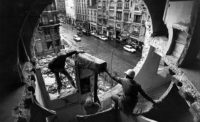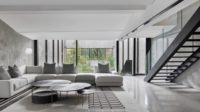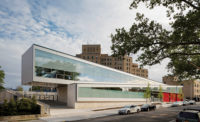Wolf-Gordon launched from a Manhattan sublet in August 1967 with not even a sample book to show clients. Eventually moving to a 15,000-square-foot Long Island City, New York, office, this once humble distributor of vinyl wallcoverings has since become a powerhouse with a product offering that includes textiles and coatings, as well as collaborations with architects and designers like Laurinda Spear, Karim Rashid, and Petra Blaisse. Earlier this year, near its 50th anniversary, Wolf-Gordon relocated its headquarters to a smaller office designed by Lewis.Tsurumaki.Lewis (LTL Architects) just steps from its first home.
Chief creative officer Marybeth Shaw asked LTL to transform the new 8,300-square-foot workplace into a contemporary, interactive space in which to showcase Wolf-Gordon’s inventory. “The primary challenge involved the shift from a roomy facility to the realities of Manhattan real estate,” says architect Marc Tsurumaki. “The space had to [achieve] more with less in terms of overlapping uses and flexible functions.” The payback: its central location and improved employee environment.
The design team fabricated an 80-foot-long armature from blackened steel by Philadelphia-based Veyko that divides open workstations from the rest of the office. More than 40 movable steel-frame panels are suspended from the structure, each displaying one of the company’s materials. The panels rearrange into various combinations, Tsurumaki explains, “to allow for differing degrees of enclosure and permeability between working and gathering areas, to orchestrate informal collaboration, and for public events, training sessions, or talks.” The interior was designed to inform visitors about Wolf-Gordon’s offerings and features many of its veneers, coatings, and wallcoverings, along with upholstery and acoustical surfacings: The dry-erase coating Wink was applied to walls, textiles designed by Mae Engelgeer are found on the lounge and reception furniture, and an acoustical fabric–wrapped panel stretches above the workstations beneath the ductwork. LTL’s strategy also embodies a lesson about good design in general: reconceiving even common elements like display systems can boost a project’s functionality.”






Post a comment to this article
Report Abusive Comment